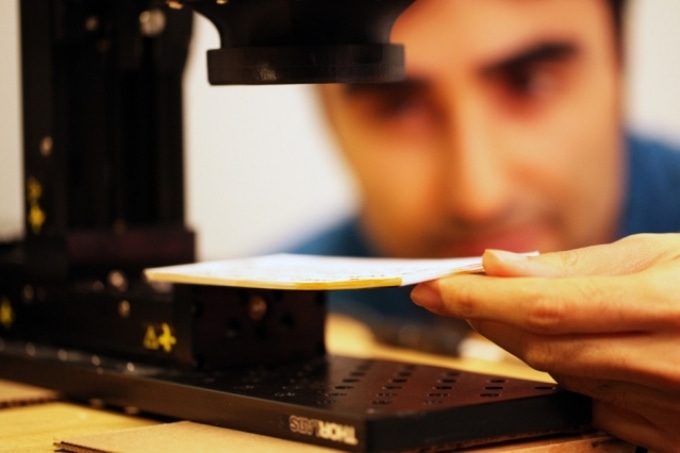Sep 13 2016
 A new imaging system can read closed books. The Metropolitan Museum in New York showed a lot of interest in this, because they want to, for example, look into some antique books that they don't even want to touch, says Barmak Heshmat, a research scientist at the MIT Media Lab. Credit: Photo courtesy of Barmak Heshmat.
A new imaging system can read closed books. The Metropolitan Museum in New York showed a lot of interest in this, because they want to, for example, look into some antique books that they don't even want to touch, says Barmak Heshmat, a research scientist at the MIT Media Lab. Credit: Photo courtesy of Barmak Heshmat.
An imaging system with the potential to read closed books is being developed by a team of MIT researchers and their colleagues.
A prototype of the system was described by the team in the recent issue of Nature Communications. This was tested on a pile of papers, where each piece had a letter printed on it. The system correctly identified the letters on nine sheets of paper.
The Metropolitan Museum in New York showed a lot of interest in this, because they want to, for example, look into some antique books that they don’t even want to touch.
Barmak Heshmat, Research Scientist, MIT Media Lab
He also states that the system is capable of analyzing different materials arranged in thin layers, for instance coatings on machine parts or pharmaceuticals.
In this paper, Heshmat is joined by Ramesh Raskar, an associate professor of media arts and sciences; Albert Redo Sanchez, a research specialist in the Camera Culture group at the Media Lab; two of the group’s other members; and by Justin Romberg and Alireza Aghasi of Georgia Tech.
The MIT team developed the algorithms that obtain images from each sheet present in the pile of papers. The Georgia Tech researchers produced the algorithm that comprehends the often incomplete or distorted images as individual letters.
It’s actually kind of scary. A lot of websites have these letter certifications [captchas] to make sure you’re not a robot, and this algorithm can get through a lot of them.
Barmak Heshmat, Research Scientist, MIT Media Lab
Timing Terahertz
The system utilizes Terahertz radiation, which is the band of electromagnetic radiation existing between microwaves and infrared light, and it has a number of advantages over a variety of waves that are capable of penetrating through surfaces, such as sound waves or X-rays.
There has been a lot of research exploring the use of terahertz radiation for security screening, because a variety of chemicals absorb varied frequencies of terahertz radiation to different degrees, yielding a unique frequency signature for each. It is also possible for terahertz frequency profiles to differentiate between blank paper and ink, in a manner that cannot be performed by X-rays.
Terahertz radiation can also be emitted in such short bursts that the distance it has traveled can be gaged from the variation between its emission time and the time at which the reflected radiation comes back to a sensor. This provides it with better depth resolution than ultrasound.
The system considers the fact that extremely small air pockets, about 20 micrometers deep, are trapped between the pages of a book. The difference in refractive index - the degree to which they bend light - existing between the paper and the air explains that the boundary between the two will reflect terahertz radiation back to a detector.
In the team’s setup, a traditional terahertz camera is found to release ultrashort bursts of radiation, and the sensor built inside the camera detects these reflections. The algorithm developed by the MIT team is capable of gaging the distance to the book’s individual pages instantly from the time the reflections arrive.
True Signals
As most of the radiation is either reflected or absorbed by the book, some of it actually bounces around between pages before going back to the sensor, producing a spurious signal. A background hum is also produced by the sensor’s electronics. The new algorithm is responsible to filter out all of this noise.
Information regarding the distance of the pages is beneficial as it allows the algorithm to hone in on the terahertz signals whose arrival times highlight that they are true reflections. It then depends on two varied measures of the reflections’ energy and also on assumptions about both the statistics of noise and the energy profiles of true reflections in order to extract information related to the chemical properties of the reflecting surfaces.
Currently, the algorithm is capable of accurately deducing the distance from the camera to the top 20 pages in a pile, but past a specific depth of nine pages, the reflected signal’s energy is so low that the variations that exist between frequency signatures are swamped by noise.
However, terahertz imaging is still considered to be growing technology, and researchers are continuously focusing on enhancing both the power of the radiation sources and the accuracy of detectors, in order to obtain deeper penetration.
So much work has gone into terahertz technology to get the sources and detectors working, with big promises for imaging new and exciting things. This work is one of the first to use these new tools along with advances in computational imaging to get at pictures of things we could never see with optical technologies. Now we can judge a book through its cover!
Laura Waller, Associate Professor, University of California at Berkeley
Reading through closed books
Video Credit: MIT Media Lab/Youtube.com